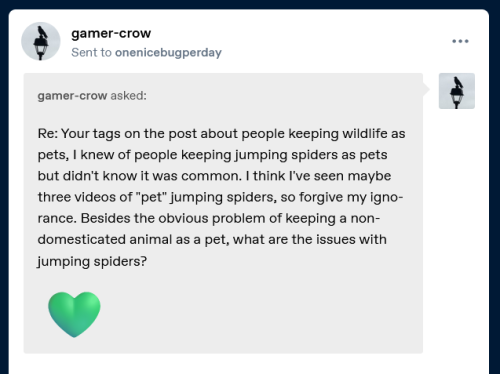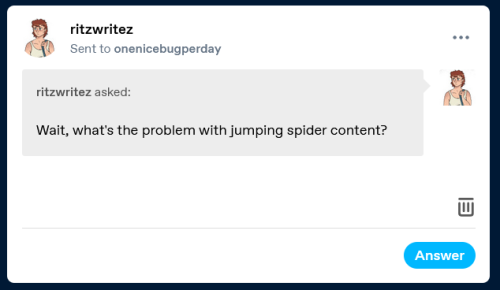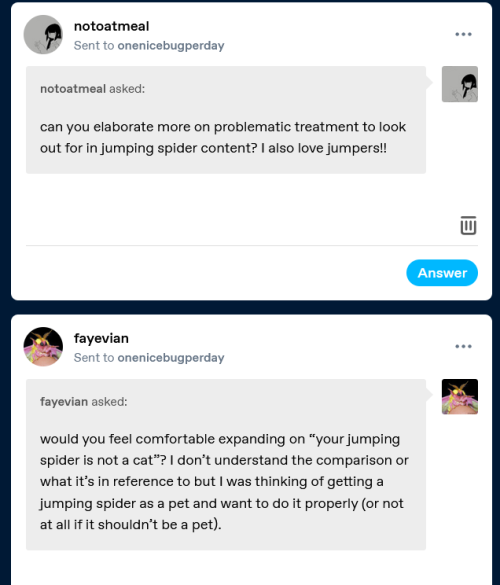Thinking About That Time Scientists Put Tracking Collars On Jellyfish

thinking about that time scientists put tracking collars on jellyfish
More Posts from Phoronopsis and Others
Conch snails actually do have some of their own tricks up their shells— their foot bears a sharpened operculum that they use to push themselves around much faster than a lot of slow predators (including cone snails) can move, or even to fight back. It's believed that their high-resolution vision, which is some of the best among all known gastropods, allows them to detect and react to predators in advance (source 1, 2)
Here's a video of a conch snail in action:

How are conchs even real
Invertebrates are definitely capable of learning! A lot of people who don’t know anything about bugs say they’re automata who just do everything by instinct like an if-then computer program, and they absolutely have not looked into it because there’s SO much literature on invertebrate cognition including learning. One of the neatest papers I’ve seen was about Drosophila fruit flies (there’s a ton of fruit fly literature cuz they’re a common lab animal). So when a female fruit fly is exposed to parasitoid wasps, she will start laying fewer eggs. These researchers showed that fruit flies who have been exposed to wasps can communicate the presence of a threat via wing movements to other female fruit flies, and those flies will start laying fewer eggs too even if they haven’t seen the wasps at all, an example of social learning.
But what’s more: they can communicate threats like this not just with flies of their own species, but with flies of closely related species too. If the species are too distant, they stop being able to communicate as successfully HOWEVER these authors showed that if you house a bunch of flies together in mixed-species groups, afterwards their success at communicating goes up! This suggests the existence of a fruit fly “language” which differs between species, but which they’re capable of learning other species’ languages as well! Sources: 1, 2
see also this very scientific diagram from here:

One interesting thing about those studies is that they found that if you raise a fruit fly in isolation from hatching, it won’t be able to communicate as well. This suggests that there’s a critical period of socialization which flies require to learn how to do communicate properly and without it their ability to do so is impaired. (I believe there’s other studies on how other social interactions are affected by social isolation but I haven’t read them; again there’s sooo much fly literature ^^)
Another cool one I’ve seen is on antlion larvae, who hunt by digging pits and then waiting in the middle for ants and other bugs walking by to fall in. It’s generally thought that sedentary animals have fewer cognitive capabilities than mobile ones, due to their less demanding lifestyle, however these studies (which I’ve only skimmed) have been carried out which demonstrate that they are still capable of learning. Specifically, they can be taught to anticipate and identify approaching insects based on vibrations in the sand, and will subsequently adapt their behavior to hunt more efficiently! Even animals with what seems like a simple feeding behavior are still very capable of modifying it, which makes sense evolutionarily; while obviously different animals will require different levels of intelligence, you can imagine in a lot of cases that being able to modify your behavior based on experience is distinctly advantageous. Source 1, 2
Not an arthropod, but another bug that there’s been a lot of research into is Lymnaea pond snails, which are another common model organism for studying neurology and cognition. A ton of work has been done on their capabilities for associative learning, i.e. classical conditioning (“dog learns to salivate at the ring of a bell”) and operant conditioning (“rat learns that pressing a button gives food”). It’s been found that their ability to learn is actually a lot more complicated than just those simple kinds of stimulus ↔ response. They can take stuff they’ve learned in stressful situations (simulated experimentally by exposing them to the smell of crayfish, which eat snails) and generalize it to situations beyond just the original context, which you can imagine must be pretty important for surviving in the wild. Conversely, they can also place memories in context: when taught stuff in the presence of both crayfish smell and carrot smell, subsequently they will recall what they’ve learned in response to the carrot smell alone; in other words, they’re not just learning “carrot + crayfish smell”, but “carrot smell = crayfish smell”, placing their memories in the broader context of their environment (which again, must be helpful for survival). So they can not just learn but pretty flexibly as well! Sources 1, 2, 3
This isn't a bug at all but pretty recently there was a study that found that box jellyfish are capable of associative learning. This one research lab has done a lot of work into vision in the Caribbean box jellyfish (they have eyes btw) on both a behavior and a neurological level and have found a lot of cool things, like that these box jellyfish use their vision to navigate through their habitat of mangrove forests, and that though they don't have a brain as such, they do have a central nervous system in the form of a ring nerve connecting four small clusters of neurons that process and combine input from their eyes. I can't actually read the paper (paywall :P) but last year they did an experiment where they put jellies in a tank with darkened bars on the glass to simulate mangrove roots. Normally the jellies gauge the distance to a root by how dark it appears and then swim around it when they get near; however the bars in the experiment were colored so that they looked like they were farther away than the wall actually was. At first the jellyfish kept bumping into the all, but after several rounds of trial and error they began to avoid them, indicating that they were able to learn from the experience! Jellyfish! Aaaaa nature is so cool. Source 1, 2, 3
I have a question! About bugs and arachnids and all them. Sorry to lump them all into one category, but I'd rather not make the same post multiple times.
My question is: Can they learn "tricks?"
By this I mean are they capable of learning, in general, I suppose. Like mice in a maze, magpies with a rock.
Also, what sorts of things have they learned? How do they learn (like watching others or from experience)?
I ask because it's something that really interests me. I know the ability to learn doesn't add or subtract value from a being, it's a curious thought as I know very, very little about beetles, and spiders, and bees, and so on!
Do they just know how to do things because it's all their kind have done since the beginning of them? Do they have to learn or are capable of it?

@onenicebugperday found this cool lookin' bug at my local library the other day. I have no clue what it is, looks kinda like a bee or a wasp but a bit lankier, it looked like it was a bit less than 2 inches long, pretty big for bug standards. I love the white fluff around its neck!






Jumping spider mimic planthoppers in the genus Rhotana
Photo 1 by tenebrionidfan, 2 by gancw1, 3 by budak, and 4 by deeqld


these are the miserable remains of a chestnut weevil (Curculio elephas) who will never again feel the joy of a freshly drilled acorn after unspeakable atrocities were perpetrated upon her by me


this is her thirty seconds later. the atrocities that she miraculously recovered from included "being gently scooped up from a branch"
(September 1st, 2024)
important anomalocaris dorsal carapace representation... the anomalocarapace...

sick and tired of inaccurate anomalocaris paleoart ,, decided to take matters into my own hands
Even if a species of bug exhibits some kind of social touch among themselves (which I believe some are known to, though for the large majority of species I doubt there's any data on it), it's not going to be welcome from a towering colossus that they literally may not even be able to fit inside their whole field of vision. I feel like a lot of people forget just how big we are compared to most bugs
you know that one popular tumblr post that goes like "humans will pet anything" "well how wonderful that we live on a planet full of things that like to be petted!", or various other posts you see around the internet saying stuff like "humans evolved hands so we could pet all the animals 😌". sometimes I wonder how much those posts might have left actual lasting damage on public perception of animal behavior, like I'm sure they didn't intend to but like... did they
Well I certainly didn’t expect to illicit so many questions when I reblogged this post and added some tags about jumping spider content online.








Firstly, let me say there’s nothing wrong with keeping jumping spiders as pets. I have one myself. She’s a captive bred regal jumping spider. She’s currently a bit over two years old. I’ve had other jumping spiders as well, but they passed of old age and in one instance, a failed molt, which is fairly common.
Before and after getting pet jumpers, I joined some jumper groups, read a lot of care guides, and watched a slew of videos about keeping them.
It became obvious pretty quickly that apparently due to their cute fuzzy appearance, large round eyes, and intelligent behavior, people (owners, admirers, and popular content creators) assign human and mammal emotions and behaviors to them, often to their detriment.
I personally believe bugs are complex creatures that can be intelligent and have emotions, but that those emotions and behaviors are NOT analogous to human or mammal behavior and ignoring their natural needs and behaviors means you’re likely not providing proper care for them.
This is mainly about handling. Bugs don’t want to be handled. They get nothing positive out of it emotionally. They don’t want to be pet or cuddle with you. They don’t want to hang out with you. You’re a big scary predator, and it likely wants to get away from you. Forcing handling can stress, injure, or kill them. That’s why I tagged the post (linked above) “your spider is not a cat.” It doesn’t seek affection from you.
I can’t tell you how many posts or videos I saw where people were super upset because they let their jumper out of its enclosure to handle it and it either escaped and got lost or they somehow crushed it and killed or injured it badly. I’ve also seen people chasing their jumper around its enclosure trying to grab it or get it to jump onto their hand when it’s clearly just trying to hide.
As an example, a very common thing I’ve seen in videos about jumpers is people saying when they lift their front legs at you and jump or climb onto you/your hands it’s because they “want uppies” and want to be pet and be close to you. This is a wild misreading of behavior. Sometimes raising the front legs is a defensive display, trying to make itself look larger to scare away a threat. Other times, they’re waving their legs around to sense and feel their environment, or preparing to jump onto something. They are arboreal, and their natural behavior is to find a high vantage point, so climbing onto the big thing (you) nearby is normal. It’s not because it seeks your affection.
Certainly if you DO handle them frequently they can get used to it, and it becomes less stressful for them. But in my opinion the dangers outweigh any positives, and I don’t handle mine. These are wild animals that have not been domesticated, even when captive bred. If you want to give them enrichment, and you should, offer them prey to chase or interesting things to explore in a larger enclosure. For those that do still handle them, I’d encourage you to watch their behavior closely and read the spidery cues they’re giving you rather than assuming they’re feeling what a cute little mammal might be feeling in the same scenario.
I could go on with specifics about certain videos, but I wasn’t planning on writing a huge post and this is already long. Also I’m sure many people would disagree with me about some things I’ve said, and I’m not going to argue about anything. This is just how I feel based on what I’ve seen of online jumping spider content, and it’s why I no longer interact with most of it.
-
 shrimp-bird reblogged this · 2 months ago
shrimp-bird reblogged this · 2 months ago -
 jacqueslasseau liked this · 3 months ago
jacqueslasseau liked this · 3 months ago -
 letters-of-the-experience liked this · 4 months ago
letters-of-the-experience liked this · 4 months ago -
 ligengeu liked this · 6 months ago
ligengeu liked this · 6 months ago -
 phoronopsis reblogged this · 6 months ago
phoronopsis reblogged this · 6 months ago -
 phoronopsis reblogged this · 6 months ago
phoronopsis reblogged this · 6 months ago



